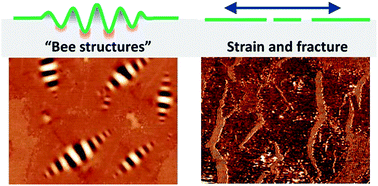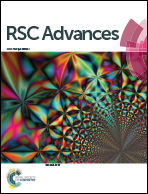AFM study of asphalt binder “bee” structures: origin, mechanical fracture, topological evolution, and experimental artifacts†
Abstract
The morphology of “bee” structures on the surface of bituminous asphalt binder was studied by AFM microscopy to provide insight into their origin. Based on how the “bees” flattened and fractured under applied tensile strain, the “bee” structures were hypothesized to be the result of wrinkling of very thin surface films on the order of 10 nm thick. Theories of thin film deformation suggest that the wavelength and amplitude of the “bees” may be related to the stiffness and thermal expansion coefficient of the bitumen. The study also showed that “bee” structures exhibited topological evolution over time depending on humidity and temperature in a manner consistent with the idea of the “bees” being composed of crystallized hydrophobic wax. The results of this paper should contribute to a better understanding of the relation between “bee” structures and bituminous material properties.


 Please wait while we load your content...
Please wait while we load your content...